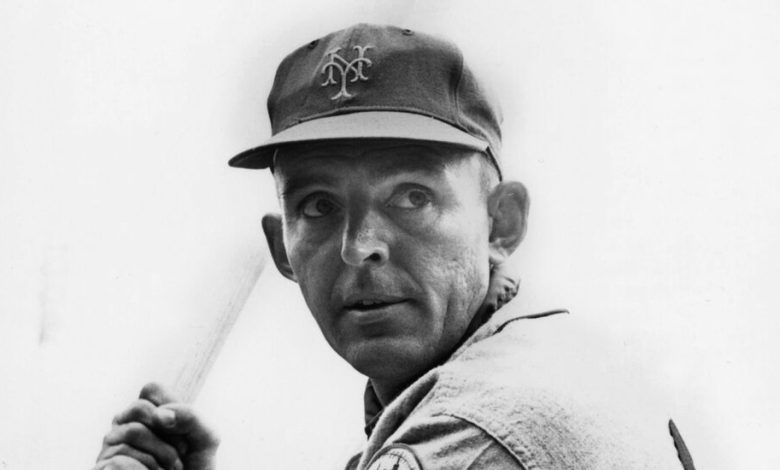Frank Thomas, Power-Hitting Original Met, Dies at 93

Frank Thomas, the slugging All-Star outfielder of the 1950s Pittsburgh Pirates who went on to hit 34 home runs for the hapless original Mets of 1962, died on Monday in Pittsburgh. He was 93.
His death was announced by the Mets.
A right-handed pull hitter who stood 6-foot-3 and weighed about 200 pounds, Thomas hit 286 home runs over 16 seasons in the National League.
But he would ultimately be far less well known than another Frank Thomas: the 6-foot-5-inch, 240-pound first baseman and designated hitter, known as the Big Hurt, who hit 521 home runs, mostly with the Chicago White Sox, in a Hall of Fame career that began in 1990 and ended in 2008.
The first Frank Thomas was an All-Star with the Pirates in 1954, 1955 and again in 1958, when he had his best season, hitting 35 home runs, driving in 109 runs and batting .281.
He later played for the Cincinnati Reds, the Chicago Cubs and the Milwaukee Braves, who traded him to the Mets in November 1961 when they were forming the roster for their National League debut.
Usually playing in left field for Manager Casey Stengel’s 1962 Mets team, which lost a record 120 games, Thomas drove in 94 runs in addition to his 34 homers — a club record that stood until Dave Kingman broke it with 36 in 1975 — taking advantage of the short left-field foul line at the Polo Grounds, the Mets’ home for their first two seasons.
But Stengel grew tired of Thomas’s penchant to pull just about everything, which he felt often led to ground-ball double plays.
The Polo Grounds had signs advertising Howard Clothes on the fences near the foul poles, offering a boat to the Mets player who hit them most often.
One day, when Thomas was being doubled up after evidently trying to hit the sign, if not slam the ball over it, Stengel shouted from the dugout, “Ya wanna be a sailor, join the Navy!”
Thomas was also remembered for his part in one of the loopier episodes of the Mets’ fledgling years.
Richie Ashburn, who would be inducted into the Hall of Fame for his play with the Philadelphia Phillies, was in center field for the Mets, alongside Thomas in left. The shortstop was Elio Chacon, a Venezuelan player who knew little if any English.
The way the story went, Ashburn became frustrated by his inability to communicate with Chacon over who would take over when a pop fly was hit to shallow left-center field. The Mets outfielder Joe Christopher, who was bilingual, suggested a solution: Ashburn should shout “I got it” in Spanish when he wanted to make the catch.
It was “Yo la tengo,” Christopher told him, and so Ashburn passed along the signal to Chacon.
One day, Ashburn told Sports Illustrated in 1992, a short fly ball descended, and “I see him whipping out from shortstop like a little kid on a scooter. So I yell, ‘Yo la tengo! Yo la tengo!’ And Elio puts on the brakes.”
Just then, Thomas came barreling in from left field, attempting to catch the ball, and collided with Ashburn as it fell safely. No one had told Thomas about “Yo la tengo.”
In the early 1980s, the New Jersey musicians Ira Kaplan and his wife, Georgia Hubley, formed a rock band. Kaplan, a Mets fan since he was a youngster, had read about the Thomas-Ashburn-Chacon mix-up. He called the band Yo La Tengo, and the name stuck. The band has remained active to this day.
Thomas professed to have enjoyed his two-plus seasons with the Mets. But, he said, there was one thing that disappointed him beyond all those losses.
“I hoped I’d make a lot of money in New York through endorsements,” he told Danny Peary for his oral history, “We Played the Game” (1994). “I made about $2,000.”
Frank Joseph Thomas was born on June 11, 1929, in Pittsburgh, to Bronaslaus and Anna Marian Thomas. His father, an immigrant from Lithuania, was a foreman in a laundry. He had two sisters and a brother.
He loved playing baseball from childhood, but his parents sent him to a Roman Catholic seminary in Ontario, hoping he would become a priest. He played baseball there and then signed with the Pirates’ organization.
Thomas made his debut with Pittsburgh in August 1951, but he did not play regularly until Ralph Kiner, one of the great home run hitters of his era, was traded to the Cubs in June 1953.
When Thomas joined the Mets, he had a reunion of sorts with Kiner, who was embarking on his long run as a Mets broadcaster.
Among the highlights of Thomas’s 1962 season were three consecutive games in early August in which he hit a pair of home runs.
But the next season he hit only 15 home runs and drove in only 60 runs. He was traded to the Philadelphia Phillies in August 1964.
He later played for the Houston Astros and again for the Milwaukee Braves before rejoining the Cubs, who released him early in the 1966 season, ending his career.
In addition to his 286 home runs, Thomas drove in 962 runs in his career and had a .266 batting average.
Thomas’s wife, Dolores, died in 2012. They had eight children. Information on survivors was not immediately available.
Nearly a half-century after he retired from baseball, the first Frank Thomas made it to Cooperstown, having been invited there when the second Frank Thomas was inducted into the Hall of Fame in July 2014.
The older Frank Thomas signed photos of himself outside a memorabilia store on Main Street, wearing a Pirates jersey and cap.
And, he happily remarked, “My name is always going to be in the Hall of Fame.”
